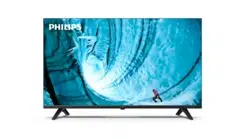Loading ...
Loading ...
Loading ...

• Reset all TV settings, go to >
> > .
• Check the connections of the source/input devices.
If the TV picture is distorted or variable in quality, the
input signal might be poor. A weak digital signal is seen
as a picture that is breaking up in square blocks and
freezes occasionally. Much sooner than a bad analogue
signal, a bad digital signal will fall away.
• Check if the antenna cable is properly connected.
• Large loudspeakers, unearthed audio devices, neon
lights, high buildings and other large objects can
in�uence reception quality when you are using an
antenna. Try to improve the reception by changing the
antenna direction or moving devices away from the
TV. Bad weather might deteriorate the reception.
• Check if all connections, to and from your devices, are
properly connected.
• If reception on only one channel is poor, �ne-tune this
channel with
. (Only for
analogue channels)
• Check if the incoming digital signal is sufficiently
strong. While watching a digital channel,
press and select and press . Check
the and .
• Make sure that the device is connected properly. Make
sure that the device's output video setting is the highest
possible resolution if applicable.
• Restore picture style or change to another picture style.
Make sure that
is set to . You can change
and save settings in this mode.
> > >
If an on screen promotion banner appears occasionally
or the
automatically switches back to
at startup, the TV is in location. Set the TV to
location for use at home.
> > >
• If the picture size - its aspect ratio - does not �t the
screen, with black bars on the top and bottom or left and
right side of the screen, press
>
> > > .
• If the picture size changes all the
time, press > > >
> .
• If the position of the picture is incorrect on the screen,
try to check the signal resolution and output type of the
connected device, press
>
> > > .
Make sure that your PC uses the supported resolution
and refresh rate.
• Check if the sound settings of the TV are OK, press
the volume or mute key.
• If you use a digital receiver (set-top box), check if the
volume on this receiver is not set to zero or mute.
• Check if the TV - the audio signal - is properly
connected with the Home Theatre System, if you use
such a system for the TV sound. Check if you connected
the HDMI cable to an connection on the
Home Theatre System.
• Make sure that the TV audio output is connected to the
audio input on the Home Theatre System.
Sound should be heard from the HTS (Home Theatre
System) speakers.
If you watch a video from a plugged in USB �ash drive or
connected computer, the sound from your Home
Theatre System might be distorted. This noise is heard
when the audio or video �le has DTS sound but the
Home Theatre System has no DTS sound processing. You
can �x this by setting the
of the TV
to .
Press >
> > >
• Note that HDCP (High-bandwidth Digital Content
Protection) support can delay the time taken for a TV to
display content from an HDMI device.
• If the TV does not recognise the HDMI device and no
picture is displayed, switch the source from one device to
another and back again.
• This is an Ultra HD TV. Some older devices - connected
with HDMI - do not recognise an Ultra HD TV
electronically and might not work correctly or show
distorted picture or sound. To avoid the malfunctioning
of such a device, you can set the signal quality to a level
the device can handle. If the device is not using Ultra HD
signals, you can switch off Ultra HD for this HDMI
connection.
If the picture and sound of a device connected with
HDMI is distorted, check if a different
setting can solve this problem. In >
, press the colour key and look
57
Loading ...
Loading ...
Loading ...
